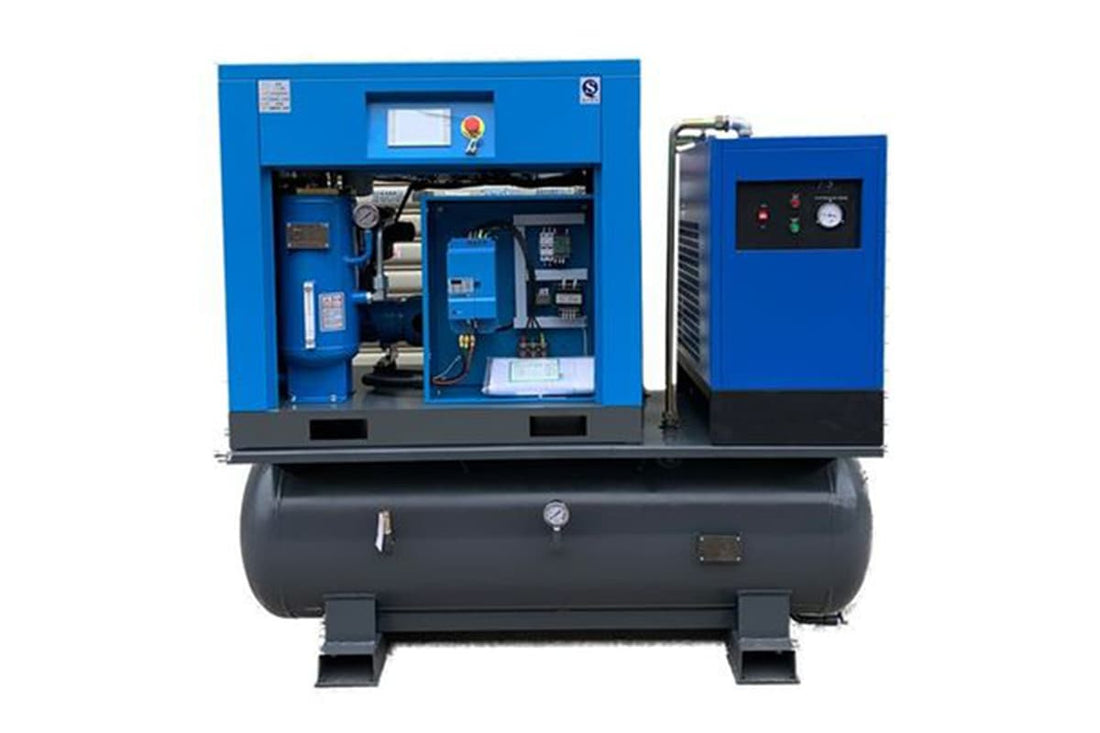Choosing and setting up an air compressor for a laser cutting machine is a complex process that requires consideration of several factors, including pressure, flow rate, and air quality. Here are some conclusions we drew:
Pressure Requirement: Laser cutters typically require an air pressure of between 10 and 16 kg. Most laser cutters use a screw-type air compressor with a pressure of 13 to 16 kg, indicating that this is the primary demand within this pressure range.
Flow rate requirement: The amount of gas a laser cutter uses depends on its power and the material and thickness of the object being cut. For example, for a 3,000-watt laser cutter, the corresponding air compressor flow requirement can be determined by consulting a flow chart or asking the laser cutter manufacturer.
Air quality: To ensure the quality and effectiveness of laser cutting, compressed air needs to be clean, dry and stable. Therefore, in addition to the basic pressure and flow requirements, special attention should be paid to the configuration of compressed air aftertreatment device such as three- to four-stage piping filters, refrigerated dryers, and high-efficiency oil removers. These devices can ensure air quality and prevent moisture and oil from affecting the protective mirror of the laser cutting head.
Air compressor type: Screw type air compressor is recommended because it provides more stable, intelligent and energy-saving air supply. Furthermore, permanent magnet variable frequency screw air compressor is also recommended for its energy-saving features.
Importance of a dedicated air compressor: Laser cutters can meet the requirements of cutting various materials and complex shapes, and auxiliary gases (such as oxygen, nitrogen and compressed air) are indispensable for the cutting process. Therefore, choosing a suitable air compressor for a laser cutter is critical to improving cutting results.
In conclusion, when choosing an air compressor for a laser cutter, consider the supplied air pressure, flow rate, and air quality. Screw type air compressor, especially permanent magnet variable frequency screw air compressor, is a good choice for its stability, intelligence and energy efficiency. At the same time, to ensure the quality and effectiveness of laser cutting, suitable post-treatment devices must be configured to ensure the cleanliness and dryness of the air source.
1. Introduction
Laser cutting is a laser processing technology widely used around the world. Its use dates back to the 1970s when it was first used for cutting purposes. The rise and popularity of third-generation laser technology in the early 21st century has made laser cutting increasingly popular in the processing of materials such as sheet metal, plastic, glass, ceramics, semiconductors, textiles, wood and paper.
With the increasing demand, many laser companies have developed high-power fiber laser cutting machines. These machines have the advantage of reduced processing costs and flexible payment methods. Today, sheet metal processing companies, kitchen and bathroom manufacturers, and automotive parts processing companies are using laser cutting machines more frequently, especially in the sheet metal processing industry, where they have replaced traditional processing methods.
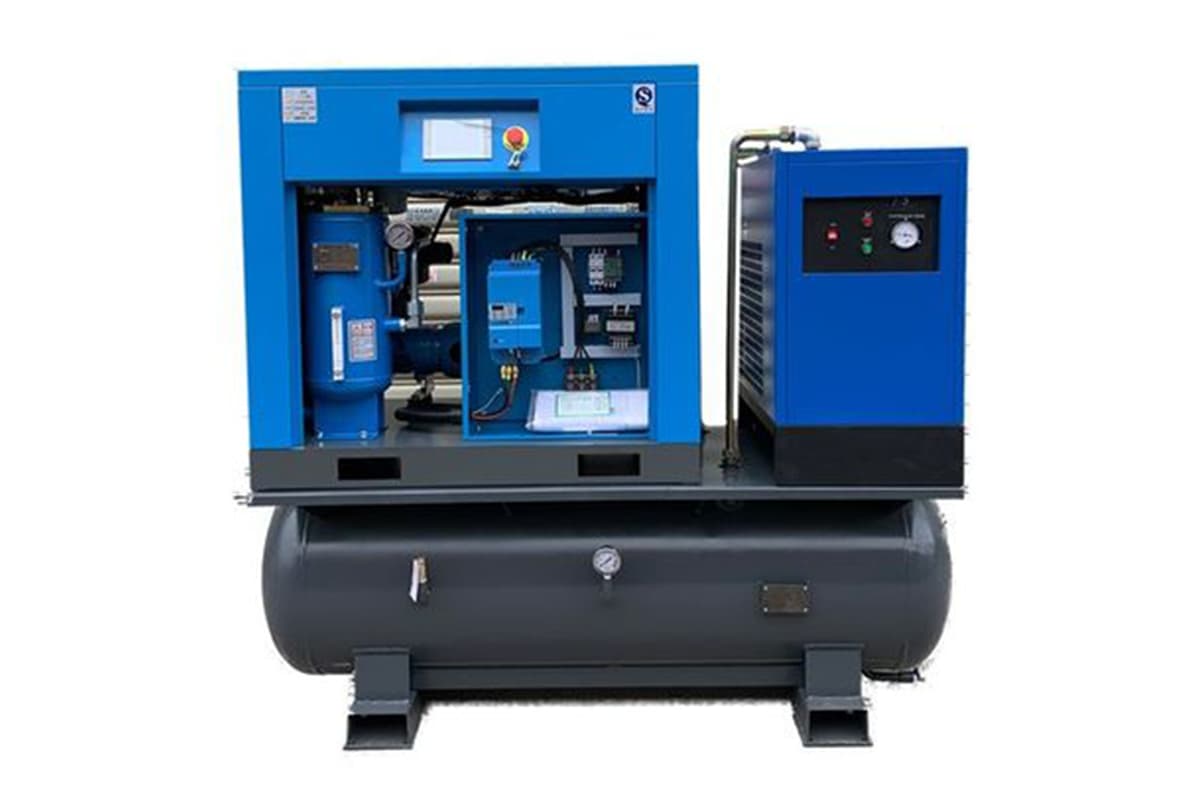
Laser cutting machines can meet the needs of cutting various materials and complex shapes. They require high-energy lasers and auxiliary gases to complete the cutting process. The most common auxiliary gases used for laser cutting are oxygen (O2), nitrogen (N2), and compressed air. Compressed air is easier to obtain and cheaper compared to oxygen and nitrogen, making it a common choice for cutting.
The quality of compressed air directly affects the quality of metal laser cutting, and the stability and size of gas pressure can affect the cutting effect. The air compressor used as the auxiliary gas for the laser cutting machine should be selected based on the laser cutting head design, auxiliary gas pressure and nozzle size to best match the laser cutting machine.
2. Principle of laser cutting
Laser cutting involves the use of a high-power, high-density laser beam that is focused on the workpiece, causing the material in the irradiated area to melt, vaporize, ablate, or reach its ignition point. The molten material is then removed through a high-velocity airflow, which is coaxial with the beam, allowing the part to be cut. Laser cutting is a thermal cutting method.
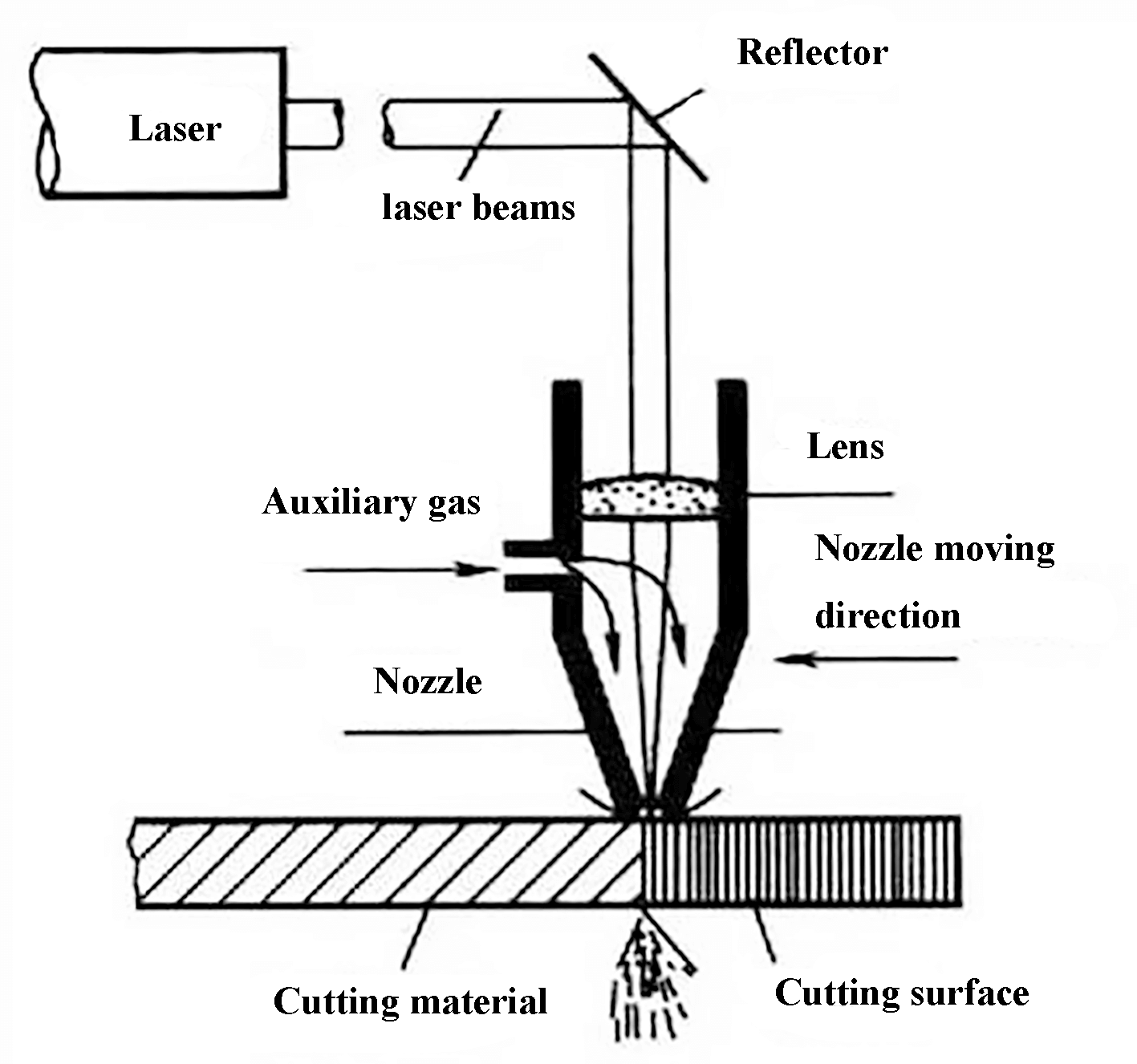
Figure 1 Principle of laser cutting
2.1M some laser cutting methods
Laser cutting can be divided into laser gasification cutting, laser fusion cutting, laser oxygen-assisted fusion cutting and controlled fracture cutting.
1) Laser gasification cutting
Using a laser beam with high power density to heat the part, the temperature increases rapidly and reaches the material's boiling point in a very short time. As a result, the material begins to vaporize and form vapor. These vapors are expelled at high speed, creating a cut in the material.
The heat required to gasify the material is typically high, so laser gasification cutting requires a significant amount of power and power density.
This cutting method is mainly used to cut extremely thin metals and non-metallic materials such as paper, fabric, wood, plastic and rubber.
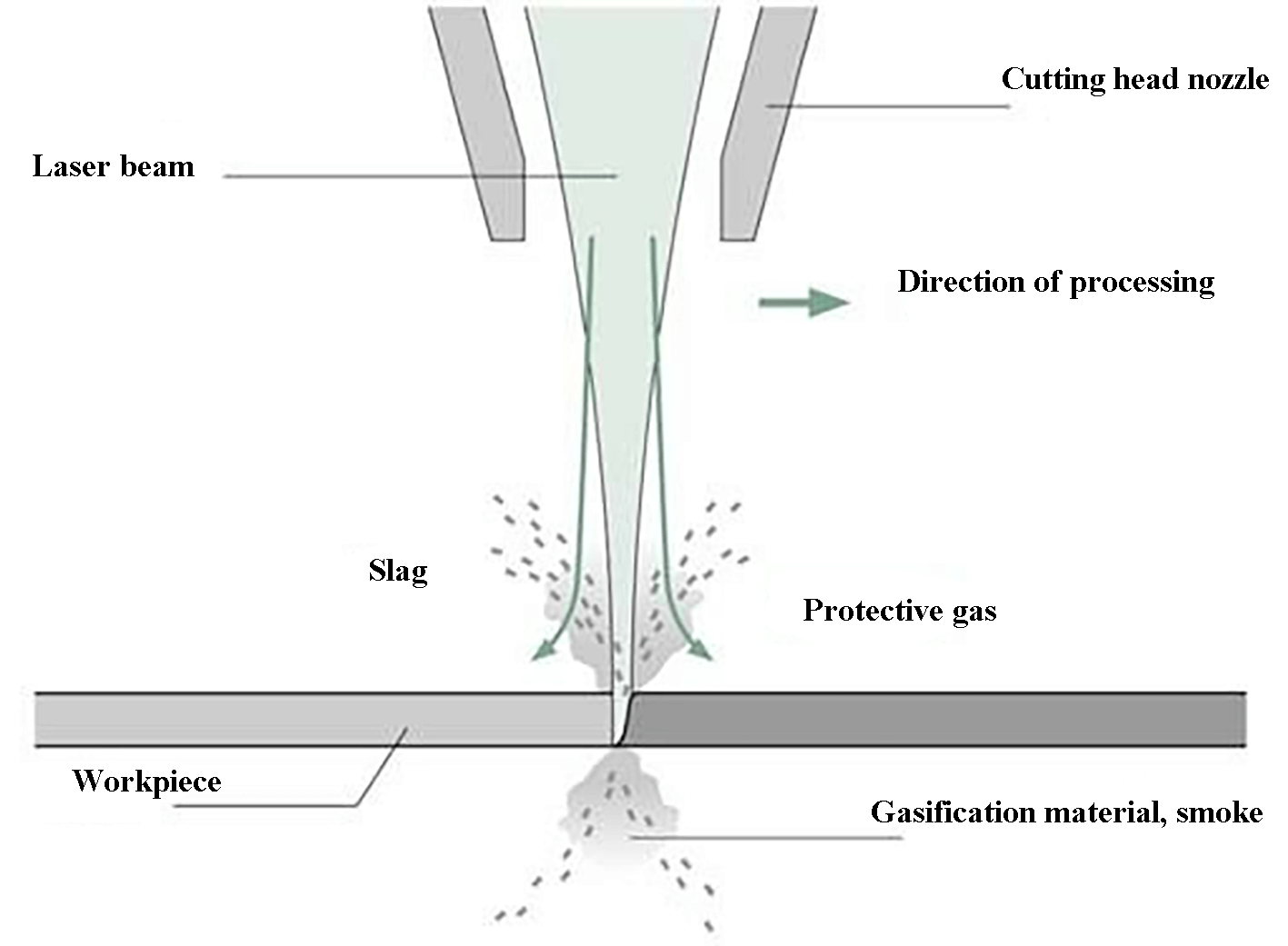
Fig. 2 Laser gasification cutting
The laser gasification cutting tip is smooth and burr-free.
2) Laser fusion cutting
Laser fusion cutting involves heating metal materials with a laser beam, causing them to melt, and then using high-pressure inert gases (such as N2, Ar and He) expelled through a nozzle to eliminate the metal liquid and form a cut.
Unlike laser gasification cutting, laser fusion cutting does not require complete vaporization of the material and only requires about one-tenth of the laser energy. When cutting sheet materials, cutting speed affects the amount of laser energy lost during cutting.
As the speed increases, more beams can hit the material and increase the power density. When cutting thick sheet materials, the defusion speed must be fast enough to prevent the laser beam from being reflected multiple times in the cut, thus interrupting the cutting process.
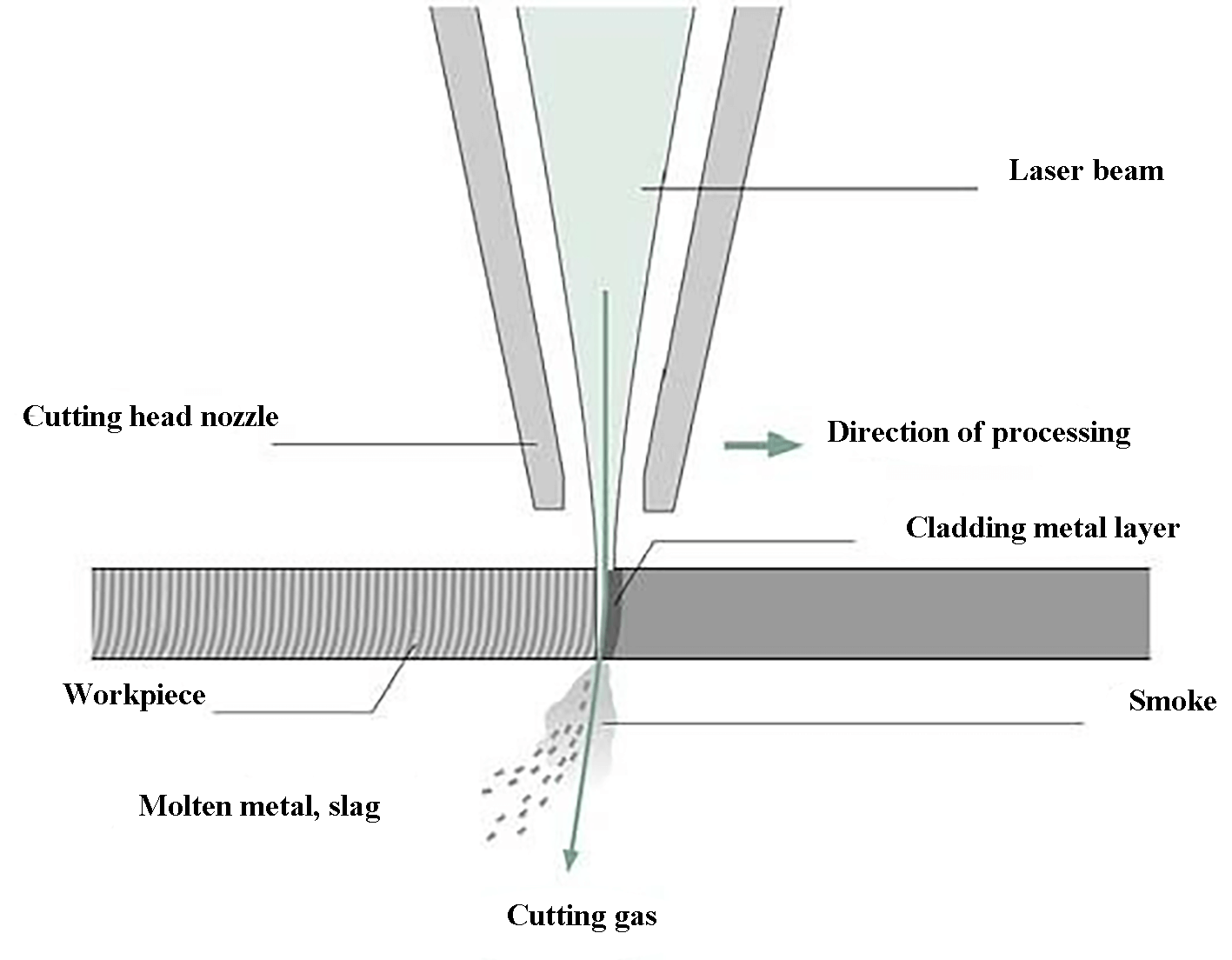
Fig.3 Laser fusion cutting
Laser fusion cutting results in a striped edge on the cut.
This method is mainly used to cut active materials or metals that are not prone to oxidation, such as stainless steel, titanium and aluminum alloys and their alloys.
Although nitrogen is used as a cutting aid gas for better quality, it also increases the cost compared to using oxygen as a cutting aid gas.
3) Laser oxygen assisted fusion cutting
The principle behind laser oxygen-assisted fusion cutting is similar to that of oxyacetylene cutting, with the laser serving as the preheating heat source and oxygen as the cutting assist gas.
On the one hand, oxygen reacts with iron that has been heated to approximately 1,500℃ by the laser, causing a large amount of oxidation heat to be continuously released, resulting in the heating and burning of the iron element.
On the other hand, molten liquid oxides and molten materials are expelled from the reaction zone, forming a cut in the metal.
The cutting process generates a significant amount of heat due to the oxidation reaction, so the energy required for oxygen laser cutting is only half of that required for fusion cutting.
Furthermore, the cutting speed is much higher than that of laser gasification cutting and fusion cutting. The edge roughness produced by laser oxygen-assisted fusion cutting is somewhere between that of laser vaporization cutting and that of laser fusion cutting.
This method is mainly used to cut carbon steel and other metals that are easily oxidized. It can also be used to process materials such as stainless steel, but the cut section will be black and rough and the cost will be lower than inert gas cutting.
4) Controlled fracture cutting
Laser controlled fracture cutting is a process of cutting brittle materials using laser beam heating in a controllable, high-speed manner.
The cutting principle involves heating a small area of the brittle material with a laser beam, which causes a thermal gradient and severe mechanical deformation, leading to cracks in the material.
The cutting speed of this process is fast and only requires a small amount of laser power, but if the power is too high, the surface of the workpiece will melt and the cutting edge will be damaged. The main parameters that can be controlled are laser power and spot size.
2.2 C characteristics of laser cutting
Compared to other cutting methods, laser cutting is known for its high cutting speed and excellent quality. Some key features of laser cutting include:
- Good cutting quality: Laser cutting offers excellent cutting quality due to the small laser spot size, high energy density and fast cutting speed.
- Thin, Narrow Cut: Laser gas cutting produces a thin, narrow incision, with the sides of the cut parallel and perpendicular to the surface.
- Smooth and beautiful cutting surface: The cutting surface produced by laser cutting is smooth and attractive, making it suitable for use as a final processing step without the need for additional machining.
- Small Heat Affected Zone: The width of the heat affected zone after laser cutting is small, preserving the properties of the material near the cut. The shape of the part is accurate and the cutting accuracy is high. A comparison of cutting speeds between laser cutting and other methods is presented in Table 1 using low carbon steel plates as the cutting material.
- Fast cutting speed: For example, a 2500W laser can cut 1mm thick cold-rolled carbon steel plates at a speed of 16-19m/min.
- Contactless Cutting: During laser cutting there is no contact between the nozzle and the part, preventing tool wear and preserving the quality of the cut.
Table 1 Comparison of cutting speed in different cutting methods
| Cutting method | Laser cut | plasma cutting | Oxyacetylene cutting | Hydraulic cutting |
| Cutting speed | Very fast | Fast | Slow | Very slowly |
3. Comparison of laser cutting with different auxiliary gases
In laser cutting, the choice of cutting gas depends on the material to be cut. The selection of cutting gas and its pressure significantly impact the quality of the laser cutting process.
3.1. Types of auxiliary gas
Commonly used auxiliary gases for laser cutting are oxygen (O2), nitrogen (N2) and compressed air. In some cases, argon (Ar) is also used. Cutting gas selection can be divided into high pressure gas and low pressure gas based on gas pressure.
3.2. Selection of auxiliary gas types
The main functions of auxiliary gas in laser cutting are as follows:
- Supporting combustion and dissipating heat
- Blow away the melted debris produced during cutting in a timely manner
- Preventing molten debris from rebounding in the nozzle and protecting the focusing lens.
When choosing different laser cutting technologies, the selection of auxiliary gas may vary according to different cutting materials and the power of the laser cutting machine.
Here are the characteristics, uses and application scopes of various auxiliary gases:
1) Oxygen
Oxygen (O2) is mainly used to cut carbon steel materials. The heat generated by the chemical reaction of oxygen and iron promotes the endothermic melting of the metal, which significantly improves cutting efficiency and allows the cutting of thicker materials, improving the performance of the laser cutting machine.
However, the use of oxygen also results in the formation of an obvious oxide film on the cut edge and has a hardening effect on the surrounding material, which may affect further processing. The cut edge of the material is black or dark yellow.
Carbon steel plates typically use oxygen cutting with low pressure drilling or low pressure cutting.
2) Nitrogen
When nitrogen (N2) is used as an auxiliary gas for cutting, it forms a protective atmosphere around the molten metal to prevent oxidation and the formation of an oxide film, thus achieving non-oxidative cutting.
However, because nitrogen does not react with metals, the cutting capacity is not as good as that of oxygen, which has a heat of reaction. Additionally, nitrogen cutting consumes several times more nitrogen than oxygen cutting, making it more expensive.
The non-oxidative cutting surface has direct welding, coating and strong corrosion resistance properties, and the incision end face is white. Nitrogen is generally used to cut stainless steel, galvanized sheets, aluminum and aluminum alloy plates, brass and other materials using low pressure drilling and high pressure cutting.
It is important to note that gas flow has a significant impact on cutting when using nitrogen. When ensuring cutting gas pressure, it is necessary to ensure adequate gas flow.
3) Compressed air
Compressed air, easily obtained and very cheap due to its direct supply from an air compressor, is the most economical and practical choice when there is no strict requirement regarding the color of the material incision.
Although air only contains about 20% oxygen, its cutting efficiency is lower than that of oxygen cutting, but its cutting capacity is close to that of nitrogen, with a cutting efficiency slightly higher than that of nitrogen cutting. The end face of the air cut appears yellow in color.
Economic Comparison Between Compressed Air Laser Cutting and Nitrogen Laser Cutting
At present, the liquid nitrogen on the market is about 1400 yuan/ton,
Liquid nitrogen for laser cutting needs a Dewar tank, which is generally 120kg/can, and the price of 1kg is more than 3 yuan.
According to 1,400 yuan/ton, the specific gravity of nitrogen in the standard state is 1.25 kg/m 3 .
Therefore, the maximum consumption of liquid nitrogen in a Dewar tank is about 120/1.25 = 96 Nm 3 .
The cost of nitrogen per Nm 3 is 168/96 = 1.75 yuan/Nm 3
If the Baode PM15TK-16 air compressor is used to supply 16 bar compressed air, it can supply 1.27 m 3 per minute.
The full load input power of this type of air compressor is 13.4 kW.
If the industrial electricity tariff is calculated as 1.0 yuan/kWh, the air cost per m 3 is 13.4 × 1.0 / (1.27 × 60) = 0.176 yuan/m 3 .
According to the actual consumption of 0.5 m3 gas per minute and the laser cutting machine working 8 hours a day, the cost saved by air cutting compared with nitrogen cutting is: (1.75 – 0.176 ) × 8 × 60 × 0.5 = 378 yuan
If the laser cutting machine works 300 days a year, the cost of gas consumption can be saved: 378 x 300 = 113,400 yuan,
Therefore, using compressed air instead of nitrogen cutting is very economical and practical .
The gas cost saved in one year is enough to purchase three high-quality integrated air compressors.
4) Argon
Argon is an inert gas that can prevent oxidation and nitriding during laser cutting and can also be used in solution welding. However, the cost of argon is higher than that of nitrogen, making the use of argon in laser cutting in general uneconomical.
Argon cutting is mainly used to cut titanium and titanium alloys, and the end face of the incision turns white after cutting.
4. Factors affecting laser cutting quality
4.1. Factors for evaluating the quality of laser cutting
There are several ways to evaluate the edge quality of laser cutting. Visual factors such as the presence of burrs, depressions and grains can be observed without the use of any instruments. However, for more technical factors such as perpendicularity, roughness and incision width, specialized measurement tools are required.
Furthermore, other factors such as material deposition, corrosion, heat affected area and deformation also play a crucial role in determining the quality of laser cutting. Common problems that can lead to poor cut quality include excessive burning and slag buildup.
The performance of the laser cutting machine, such as laser power, pulse frequency, cutting speed, focus, polarization direction, nozzle size, and auxiliary gas pressure and flow rate, affect the assessment of laser cutting quality.
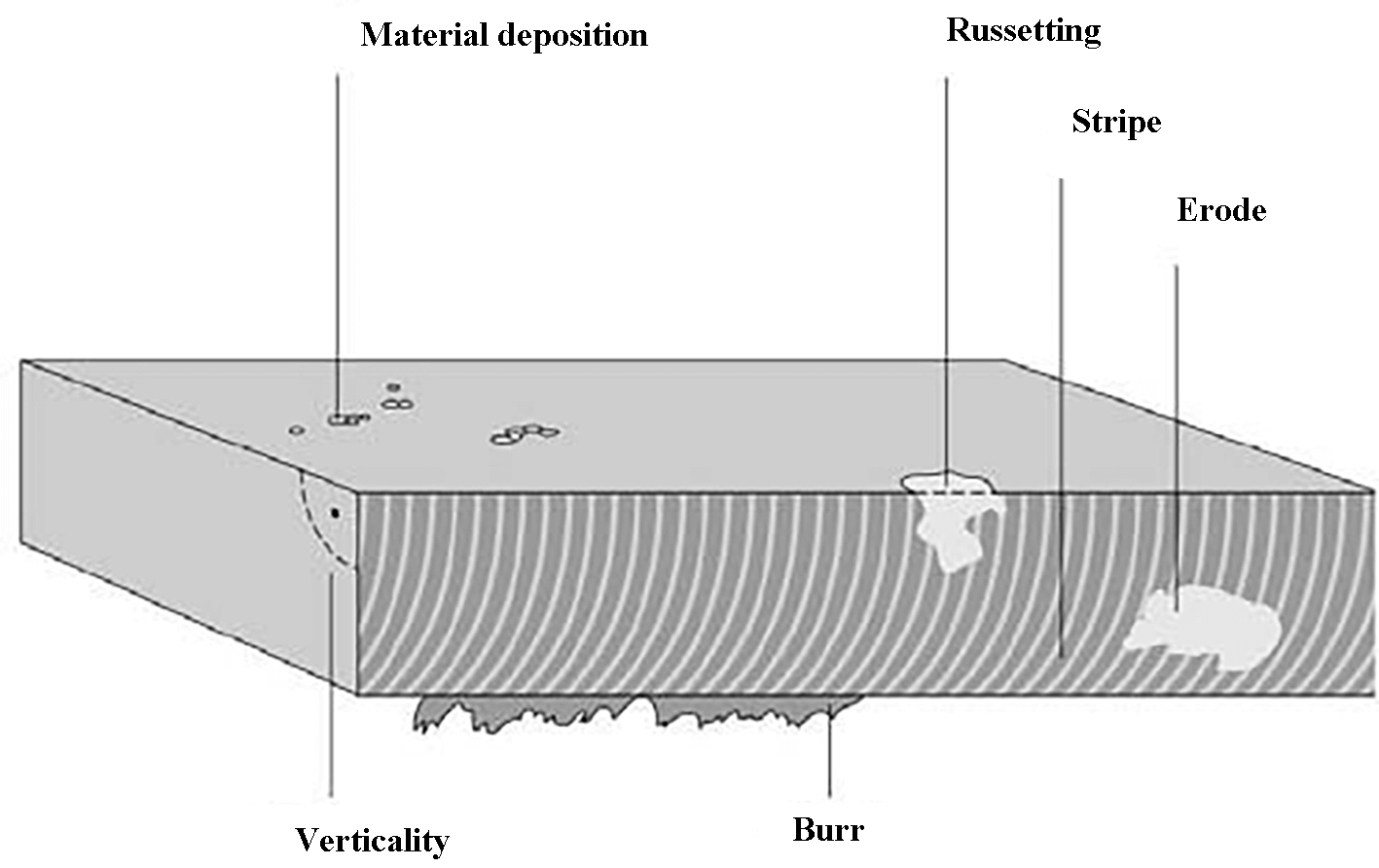
Fig. 4 Main factors for evaluating laser cutting quality
1) Overburning occurs when the heat from melting the workpiece cannot be transported efficiently by the high pressure air flow due to the laser power being too high or the cutting holes or speed being too slow. The solution to this problem is to reduce the laser power and increase the gas flow rate.

Fig. 5 Excessive burning
2) Adhered slag is also called burr.
Insufficient laser power or auxiliary gas pressure, or excessive cutting speed, causes the auxiliary gas to be unable to effectively remove the melted or vaporized materials produced during the cutting process, causing slag to adhere to the edge bottom of the cutting surface.

Fig. 6 Adherent slag
4.2. Factors for evaluating the quality of laser cutting
The position of the laser beam focus has a significant impact on the quality of the cut. Different focus positions need to be adjusted when cutting different materials.
Sometimes the presence of cutting burrs is not due to inadequate auxiliary gas pressure, but rather too high a focus. The impact of beam focus position on cut quality is shown in Figure 7.
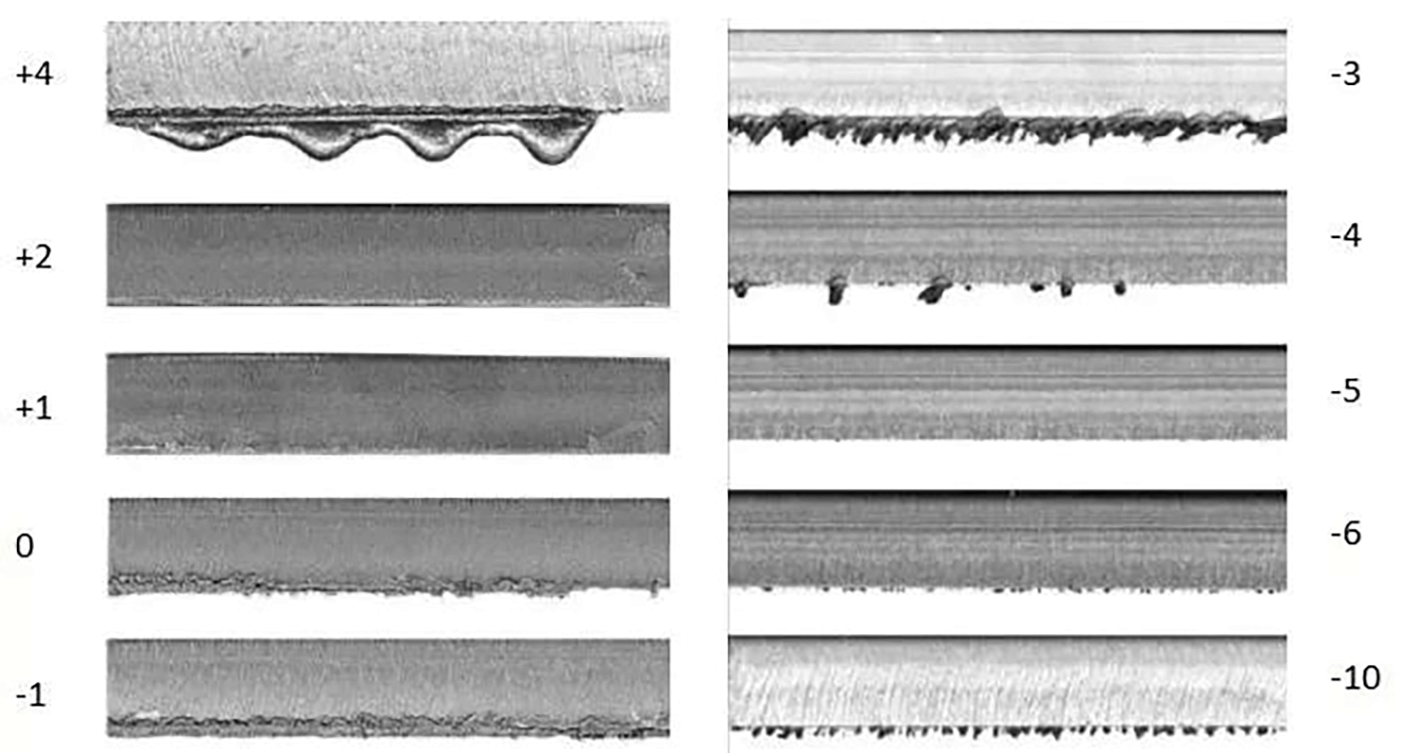
Fig. 7 Influence of beam focus on cutting effect (carbon steel: 15mm, stainless steel: 8mm)
4.3. Influence of cutting speed on cut quality
1) Cutting speed is very fast
- May cause impossibility to cut due to spark splashes;
- Some areas can be cut, some areas cannot be cut;
- The entire cutting section is rough;
- A diagonal cut pattern is formed and slag is produced at the bottom of the plate (Fig. 8).
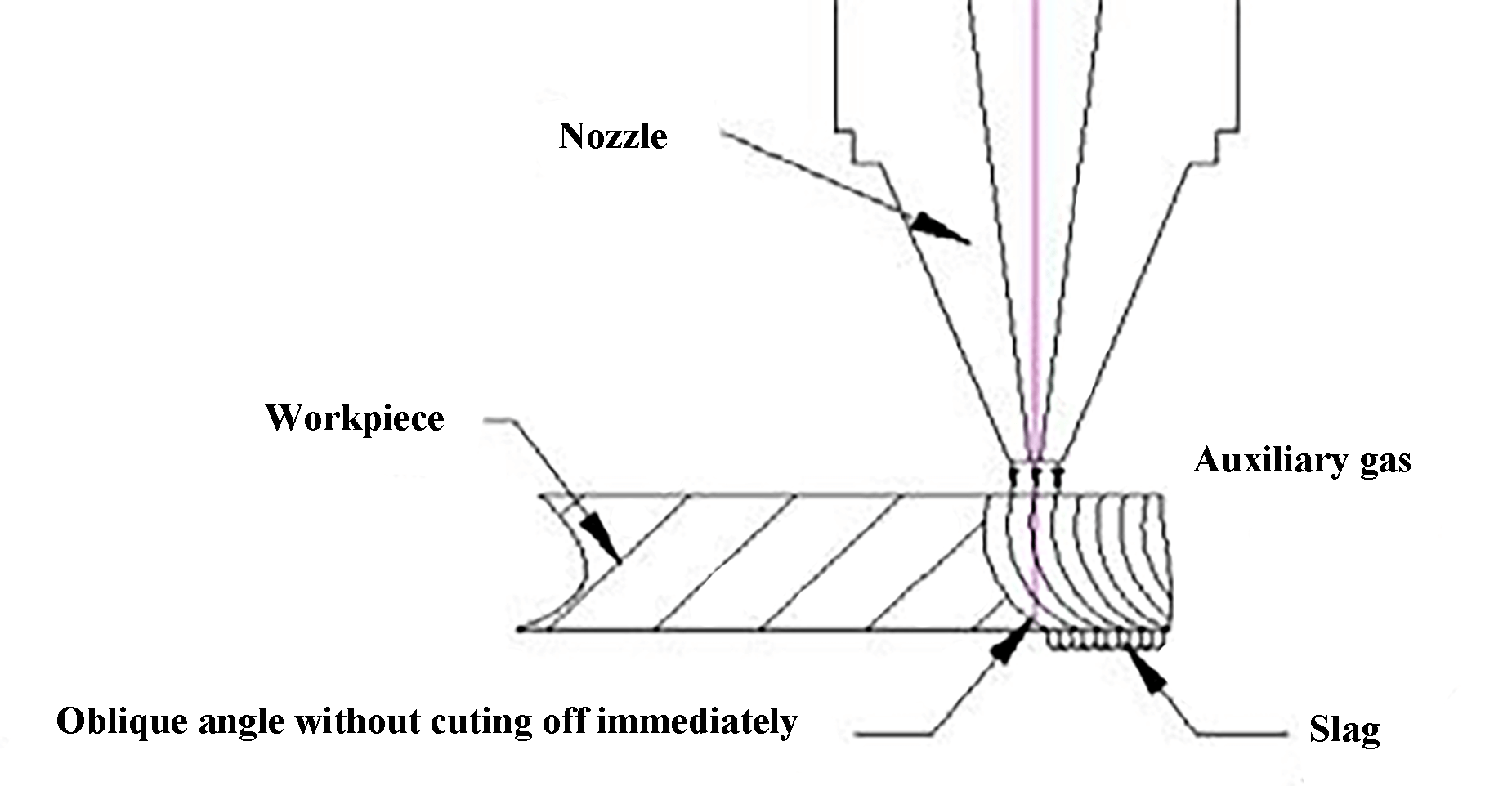
Fig. 8 Effect of very fast cutting speed
2) Cutting speed is too slow
- The results show that the cutting plate is overcast and the cutting section is rough;
- When the cutting seam is widened, the entire area will melt into the small fillet or sharp corner, resulting in excessive burning;
- Cutting efficiency is reduced.
4.4. Influence of the nozzle on the quality of laser cutting
The position of the nozzle center relative to the center of the laser beam affects the quality of the cut. When the centers are misaligned, the high-speed airflow from the nozzle can cause molten material to accumulate on one side, resulting in slag and making cutting difficult.
It is important to choose an appropriate nozzle size.
When cutting thick sheet metal, a large nozzle is required to accommodate the large diameter of the laser beam. However, a large nozzle also has its disadvantages. Low air flow speed and weakened ability to blow molten material can lead to the formation of burrs in the cutting section.
Additionally, the large size of the nozzle can cause slag and smoke generated during laser cutting to splash onto the nozzle, potentially damaging the protective lens. For high-power laser machines, the reflected laser beam may even burn the laser head.
4.5. Influence of compressed air quality on laser cutting quality
The quality of compressed air greatly affects the result of laser cutting.
Compressed air often contains water and oil mist, which if not cleaned can seriously affect the transmission of the laser beam through the protective mirror of the laser cutting head, causing it to lose focus, resulting in incomplete cuts and production. waste.
In the case of super high-power laser cutting machines, even the smallest amount of oil film or water mist on the mirror or nozzle surface can lead to high-energy laser emission that can burn the laser head.
The laser head price for a super high-power laser cutting machine (over 12,000W) is over 20,000.
However, many air compressor suppliers cannot effectively remove oil and moisture from compressed air.
As a result, most users of ultra-high-power laser cutting machines are reluctant to use compressed air as an auxiliary gas due to potential risks.
Figures 9 and 10 illustrate the difference between uncontaminated and contaminated lenses, respectively.
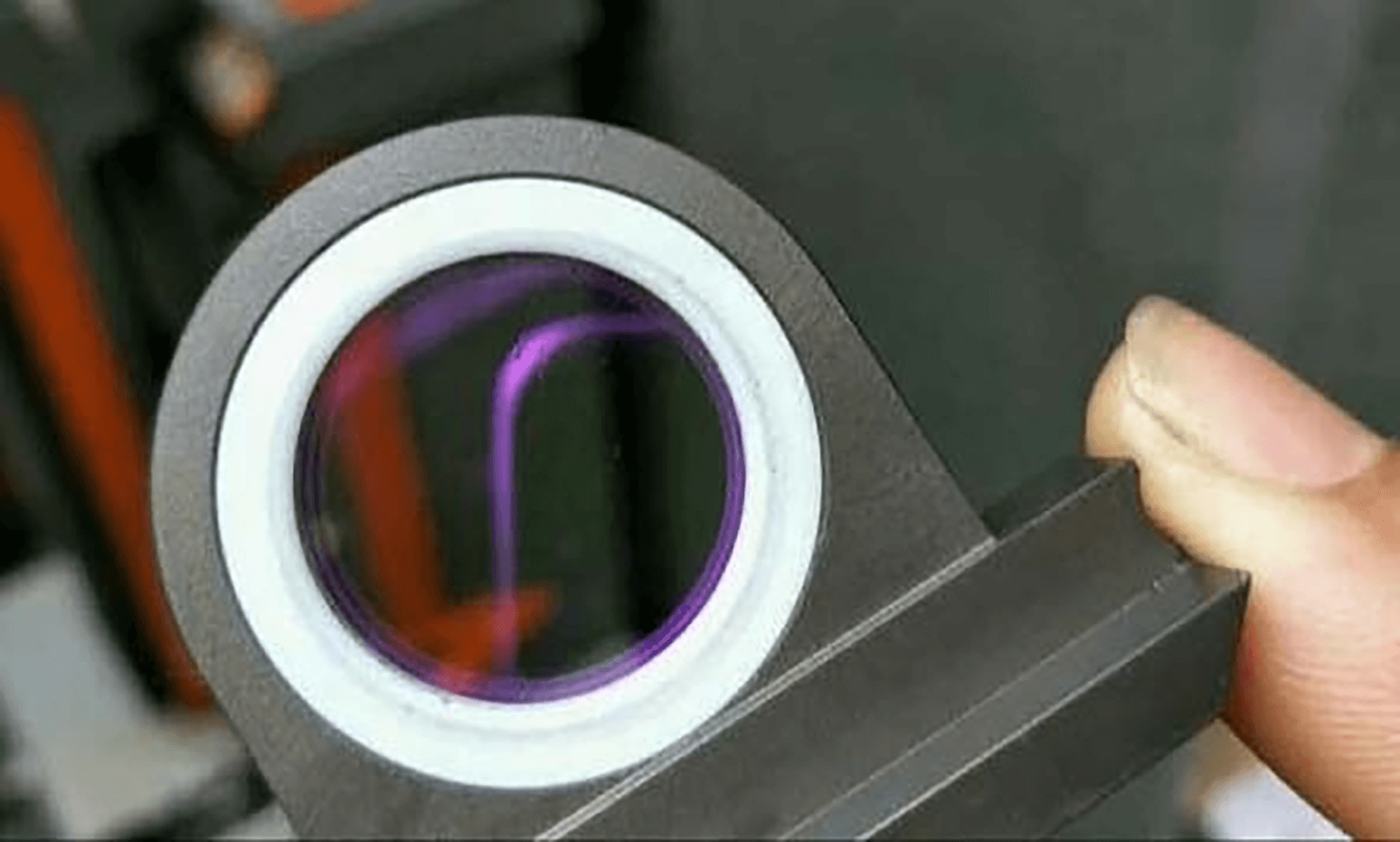
Fig. 9 Uncontaminated lenses
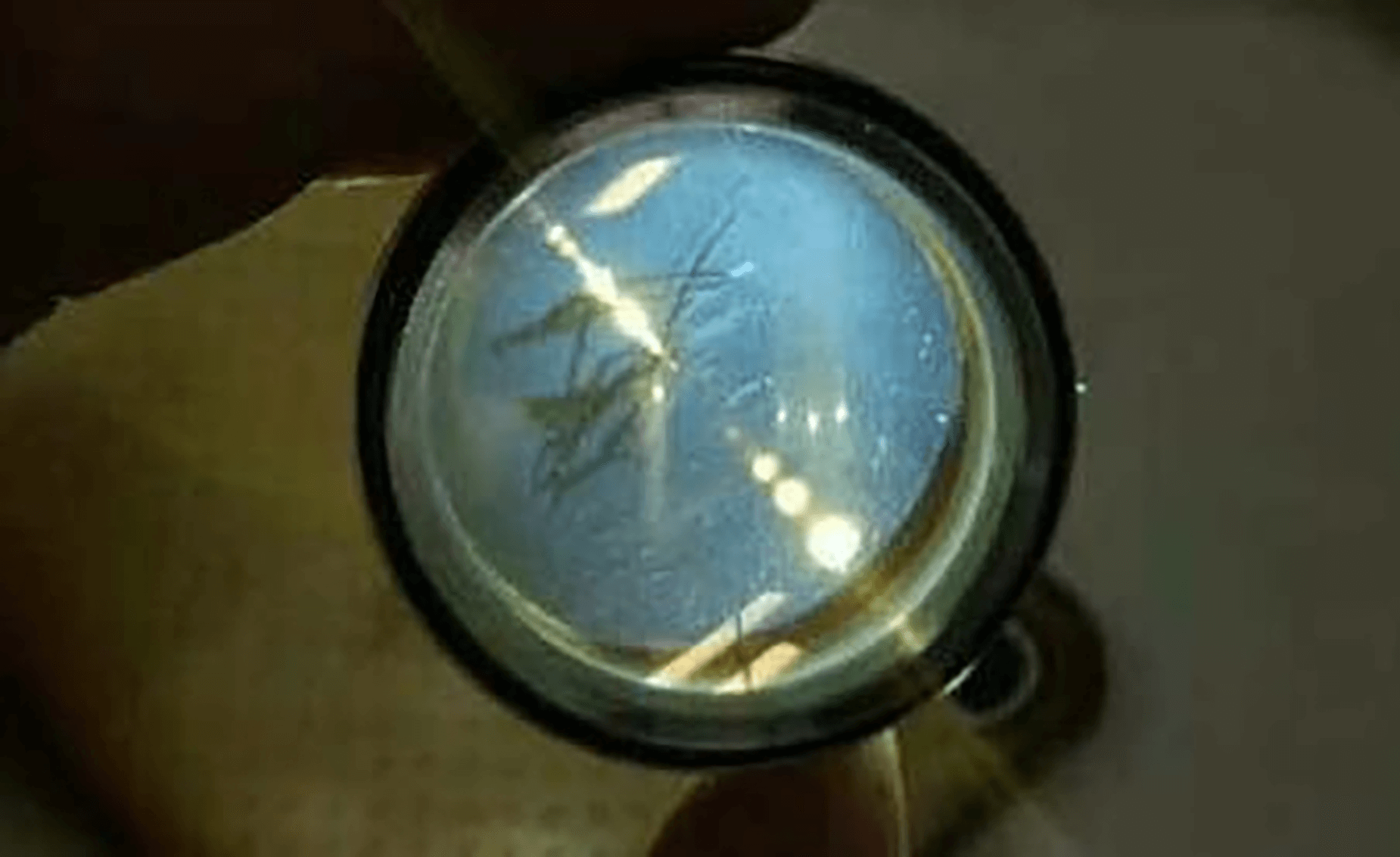
Fig. 10 Contaminated lenses
5. The factors affecting the thickness and efficiency of metal laser cutting
A comprehensive consideration of laser power, auxiliary gas type, pressure and flow rate is necessary when selecting an air compressor for a laser cutting machine.
This is based on the results of numerous practices that demonstrate that these factors have a large impact on the thickness and efficiency of metal laser cutting.
The influence of laser power and auxiliary gas pressure on laser cutting ability is shown in Fig. 9, according to experiment 4 of a laser cutting research study conducted by Tsinghua University. The cutting speed was 3 m/min, with a spot diameter of 0.16 mm, a conical shaped nozzle, a diameter of the bottom of the nozzle of 1.5 mm and a distance of 1 mm between the nozzle and the workpiece.
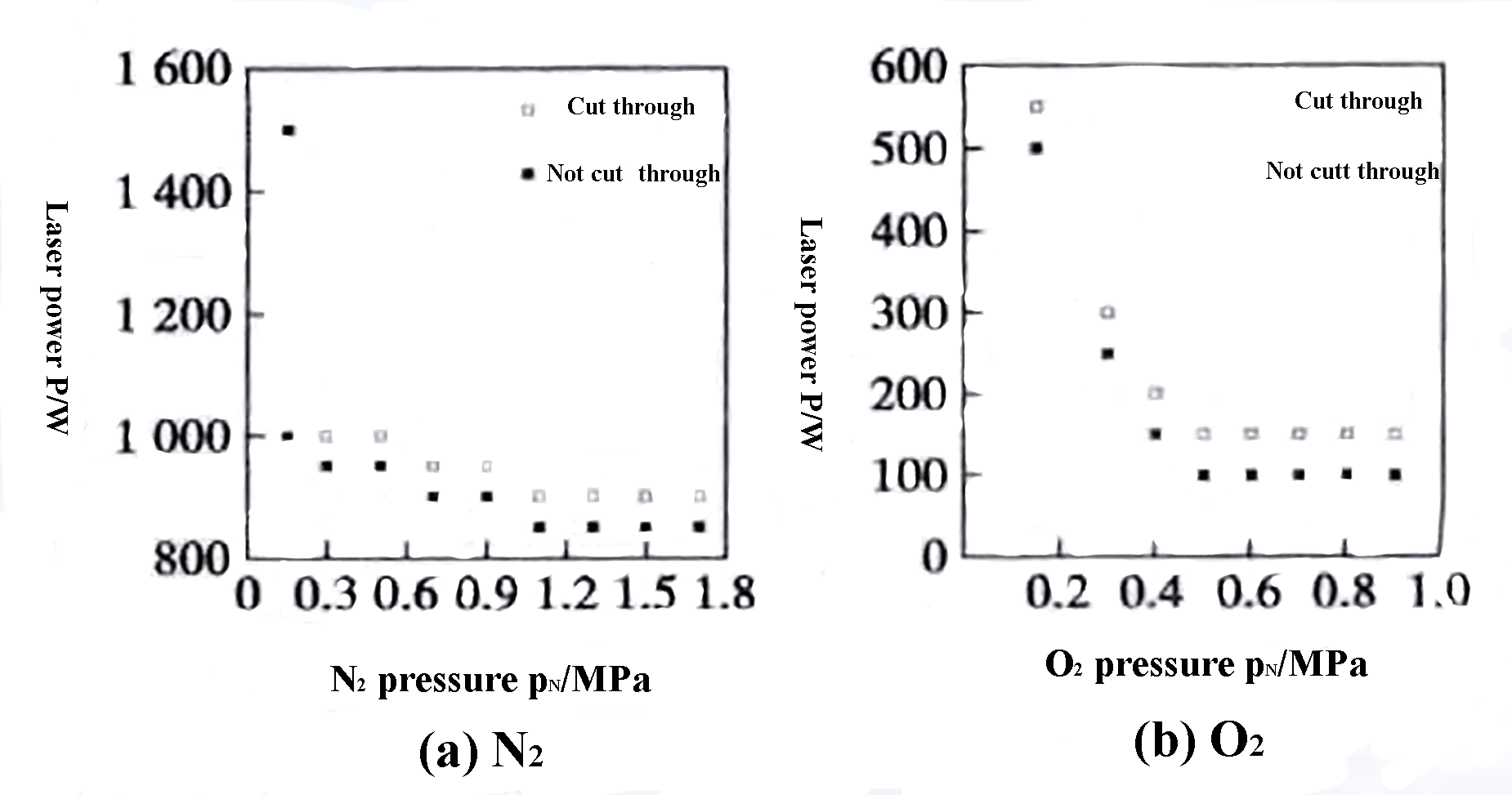
Fig. 11 Influence of laser power and auxiliary gas pressure on laser cutting capacity
As shown in Figure 11 (a), it can be seen that for a 2 mm thick low carbon steel plate, if the laser power is less than 860 W, the workpiece cannot be cut no matter how much the auxiliary gas pressure. nitrogen is increased. This occurs because the energy provided by the laser is not enough to penetrate the part.
On the other hand, if the laser power is adequate to penetrate the workpiece, then the higher the laser power, the lower the auxiliary gas pressure required.
From Figure 11(b), it can be seen that when oxygen is used to cut the same thickness of low-carbon steel plate, the influence of laser energy and auxiliary gas pressure on the cutting ability is comparable. to nitrogen cutting. However, the laser power and auxiliary gas pressure required for cutting are significantly reduced.
This occurs because oxygen reacts with iron during the cutting process, releasing about four times the laser's power. This is why general medium-power laser cutting machines tend to prefer oxygen cutting when cutting low-carbon steel plates 2mm or more thick.
When cutting carbon steel plates with compressed air, there is about 20% oxygen in the air. This portion of oxygen also reacts with the iron element and releases heat during the cutting process, making the cutting efficiency of carbon steel sheets with compressed air slightly higher than with nitrogen.
Additionally, the cutting capacity of laser cutting machines varies between manufacturers due to differences in laser and technology, and this post references public data from several representative manufacturers for comparison.
Table 2 Maximum cutting thickness of Han laser cutting machine, mm
Using IPG fiber laser
| Material | 1000W | 1500W | 2,000W | 2500W | 3000W | 4000W |
| Low carbon steel | 10 | 12 | 16 | 20 | 22 | 25 |
| Stainless steel | 4 | 5 | 6 | 8 | 12 | 16 |
| aluminum alloy | 4 | 5 | 6 | 8 | 12 | 16 |
| copper alloy | two | 3 | 4 | 5 | 6 | 8 |
Table 3 Maximum cutting thickness of HG laser cutting machine, mm
Marvel Series Fiber Laser
| Material | 3300W | 4200W | 6000W | 8,000W | 10,000W | 12,000W |
| Low carbon steel | 20 | 20 | 22 | 25 | 25 | 25 |
| Stainless steel | 10 | 12 | 20 | 25 | 30 | 40 |
| aluminum alloy | 10 | 12 | 20 | 25 | 30 | 30 |
| Brass | 6 | 8 | 12 | 14 | 16 | 20 |
Table 4 Maximum cutting thickness of Bystronic laser cutting machine, mm
| Material | 500W | 1000W | 2,000W | 3000W |
| Low carbon steel | 6 | 10 | 16 | 20 |
| Stainless steel | 3 | 5 | 8 | 10 |
| aluminum alloy | two | 3 | 5 | 8 |
| Brass | two | 3 | 5 | 8 |
Due to the reduction in laser costs, the overall cost of laser cutting machines has greatly decreased. Currently, most metal processing users purchase laser cutting machines with a power of 3000 to 4000 W.
However, a small number of metal processing users in the metal materials market mainly choose ultra-high-power laser cutting machines with a power of 12,000-15,000W.
As a result, laser cutting can normally be used for low-carbon steel plates with a thickness of less than 22-25mm, as well as for stainless steel plates, aluminum alloy plates and copper alloy plates with a thickness of less than 10. -16mm.
Between them,
- Low carbon steel plate with a thickness of less than 2-2.5mm should be cut with high pressure compressed air;
- Low carbon steel plate with a thickness of 2-2.5mm should be cut with oxygen;
- Stainless steel plate, galvanized plate, aluminum alloy plate and copper alloy plate must be cut with nitrogen or high pressure compressed air.
6. Air compressor selection
6.1. Selecting air compressor pressure and displacement
According to previous discussions, the thickness of the board that can be cut by a laser cutting machine equipped with an air compressor mainly depends on the laser power and is not significantly affected by the pressure of compressed air.
If the laser power is sufficient, the compressed air pressure will not affect the cutting ability. On the other hand, if the laser power is not strong enough, increasing the compressed air pressure will not improve the cut.
However, if the laser power is sufficient, higher compressed air pressure leads to better laser cutting quality and higher cutting efficiency. The development of laser cutting machine power has progressed from small to medium, high and even superpower over time.
The pressure requirements of air compressors supporting laser cutting machines have evolved over time, starting at 8 bar, increasing to 13 bar two years ago and currently 16 bar, with plans to reach 20-30 bar in the future.
The compressed air, after being dried and purified, is divided into three channels for the laser cutting machine that uses it as an auxiliary gas: cutting gas, cylinder power source and optical path positive pressure dust removal gas to ensure proper operation.
Cutting gas represents approximately 80-90% of total compressed air consumption. Machines that do not use compressed air as an auxiliary gas, but use nitrogen or oxygen, still require a small air compressor to provide a cylinder power source with a 6 to 7 bar atmospheric air source.
To determine the required amount of air compressor for laser cutting machines that use compressed air as an auxiliary gas, it is necessary to calculate the compressed air flow through the nozzle.
The absolute air pressure before and after the nozzle is represented as P and P0, respectively. Based on the nozzle theory, when P0/P is less than or equal to 0.528, the flow rate of compressed air passing through the nozzle in the standard state can be calculated.

Where,
- Q – air flow, L/min
- S – effective nozzle area, m 2

- μ – flow coefficient, μ <1, generally taken as 0.92-0.94
- A – beak area
- d – nozzle diameter, m
- p – absolute pressure in front of the nozzle, Pa
- T – gas stagnation temperature in front of the nozzle, K
- p – absolute pressure in front of the nozzle, Pa
- T – gas stagnation temperature in front of the nozzle, K
The calculation of air compressor discharge must take into account the free travel time of the laser cutting machine, with the actual working time being between 50-70%. The actual required displacement, QN, can be calculated as follows:
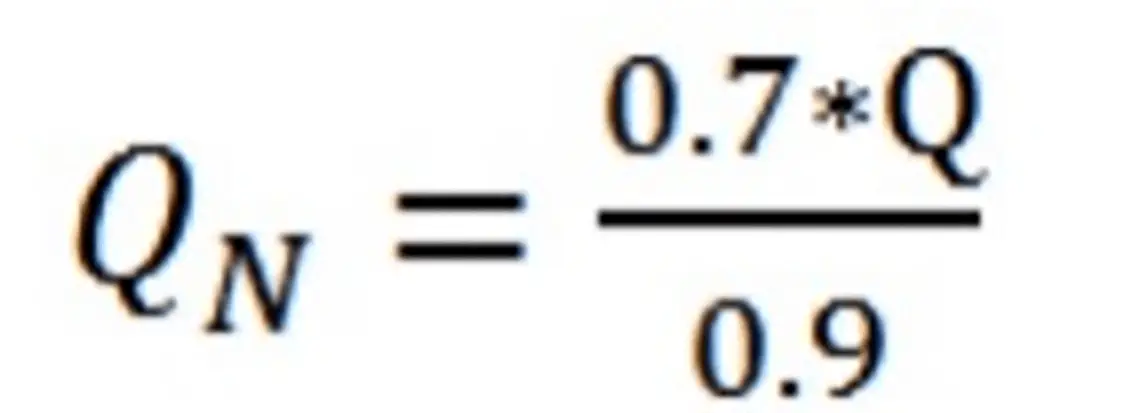
According to the power of the laser cutting machine, the seven common specifications of nozzles are: 1.0, 1.5, 2.0, 2.5, 3.0, 3.5, 4.0mm.
Figure 12 shows the auxiliary gas flow rate of the nozzles with different cutting pressures.
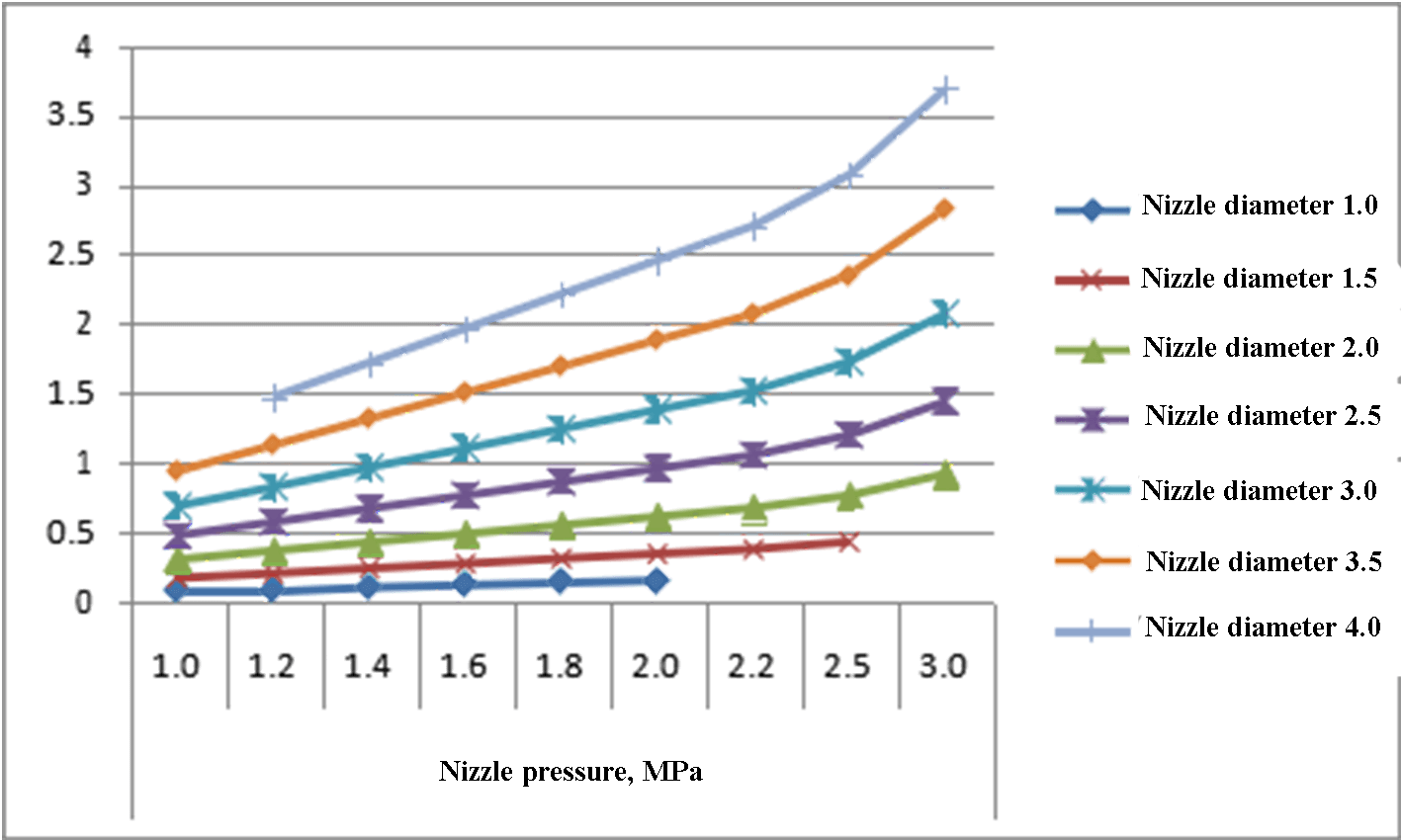
Fig. 12 Auxiliary gas flow rate of nozzles with different cutting pressures, m 3 /min
Example 1:
The user's laser cutting machine uses a 2.0mm nozzle, and the cutting pressure is expected to reach 1.6MPa absolute pressure.
How should an air compressor be equipped?
To respond:
As shown in Figure 12, a compressed air flow of 0.491 m 3 /min is required for the 2.0 mm nozzle to maintain an absolute pressure of 1.6 Mpa;
If the actual degassing time is 70% and 90% of the compressor air displacement is used for auxiliary cut calculation, the required gas volume will be: 0.491 * 0.7/0.9 = 0.382 m 3 /min, and that of two compressors is not less than 0.764 m 3 /min.
The rated discharge capacity of a Baode11TK/16 compressor is 0.97 m 3 /min, which can be equipped with two laser cutting machines with 2.0 mm nozzle (one driven twice), or a cutting machine laser with 2.5 mm nozzle.
Example 2:
How can a Baode15TK/16 laser cutting integrated air compressor be equipped with a laser cutting machine?
To respond:
The rated discharge capacity of the Baode15TK/16 compressor is 1.27 m 3 /min, which can be converted into: 1.27 * 0.9/0.7 = 1.633 m 3 /min
12, a Baode15TK/16 integrated air compressor for laser cutting can be equipped with one laser cutting machine equipped with 3.5mm nozzle or two laser cutting machines with 2.5mm nozzle (one driven two ).
6.2. Selection of air compressor type and system
The quality of compressed air has a direct impact on the quality of laser cutting, and since the laser cutting machine normally operates continuously, the air compressor is usually located close to it.
As a result, the air compressor must be equipped with an effective dryer to remove as much moisture as possible from the compressed air, followed by a group of high-precision filters with sufficient precision to completely filter out oil and dust particles.
Once post-treatment is complete, the dew point under compressed air pressure reaches 2-5°C, with a residual oil content of less than 0.001 ppm and particle content of less than 0.01 μM.
After the air dries, its temperature returns to a level close to normal, which helps to effectively prevent the recurrence of condensation.
This high-quality compressed air can sustain the long-term stable operation of the laser cutting machine and eliminates the need for frequent cleaning of the protective lenses.
The piston air compressor is capable of producing high pressure, but is known for its noise, numerous vulnerable parts, and poor handling of exhaust oil.
Therefore, it is not recommended to use a piston air compressor for pressures below 1.6 Mpa.
It is generally recommended to choose a screw-type air compressor with an appropriate cold dryer and precision filter for pressures below 1.6 Mpa.
The compressor must be equipped with a permanent magnet variable frequency motor, which maintains stability in air supply pressure and guarantees optimal cutting results.
Most users have no knowledge about air compressors and compressed air purification treatment. If users purchase the air compressor, air storage tank, cool dryer, and filter individually and attempt to install them themselves, it can be very time consuming and result in a system that does not meet quality standards of compressed air required.
An integrated air compressor combines the compressor, air storage tank, water separator, cold dryer and filter into one unit, eliminating the need for users to supply their own gas tank, cold dryer and filter, as well as the hassle of calling. on-site installation and connection and the inconvenience of dealing with multiple service providers.
It offers continuous, stable and clean compressed air, making it an ideal option for supporting high-power laser cutting machines.
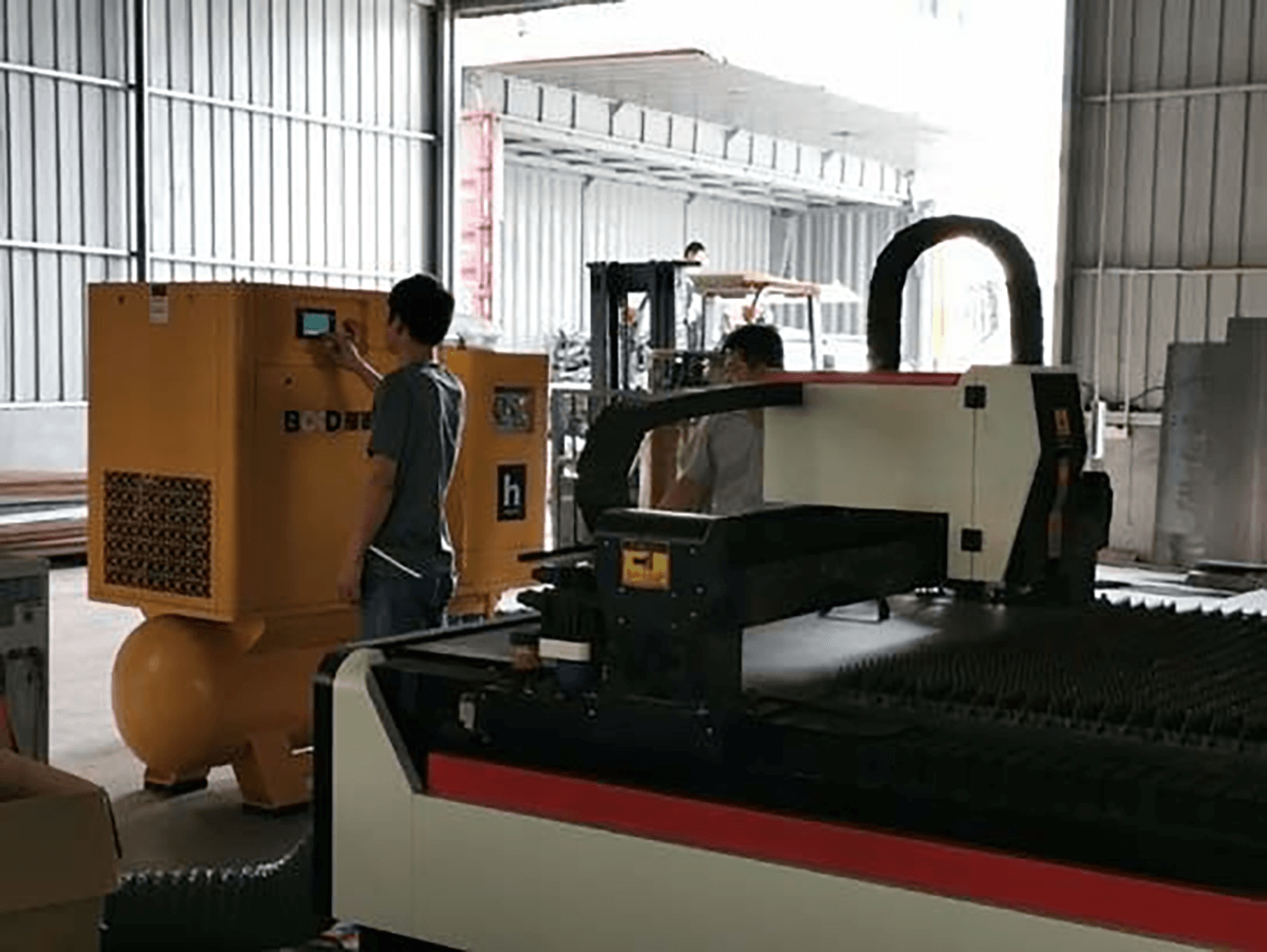
Fig. 13 Integrated air compressor for laser cutting machine
Currently, laser cutting machines that require compressed air with a pressure greater than 1.6 Mpa mainly use piston compressors, but their development has been slow due to limitations in terms of reliability and quality.
As the use of high-power laser cutting machines becomes more widespread, the demand for thick plate cutting is increasing.
It is necessary to develop a small-flow, high-pressure screw air compressor with rated discharge pressure ≥ 2.0 Mpa.
7. Problems needing attention
7.1 About – purchase cost consideration
When purchasing an air compressor for laser cutting, considering only the purchase cost may result in purchasing a substandard product.
Suppliers also need to make a profit, and if they sell a high-quality compressed air compressor system for the lowest price on the market, they will not make a profit.
For the sake of their business and profits, they may compromise on quality by using cheaper, lower quality components.
For example, to compete and increase profits, some cooling dryers with nominal treatment flow rate of 1 m 3 /min are now available on the market, but none of them can reach the nominal pressure dew point temperature of 2-8 ℃ , with actual pressure dew points above 12-16 ℃.
If a laser cutting machine uses this cooling dryer, the protective lens will need to be cleaned several times a day and the laser cutting quality will be affected.
Likewise, the oil and gas separation core and its value-adding precision filter are not cheap.
7.2 Greedy psychology
When choosing an air compressor for laser cutting, users may be inclined to choose a compressor with a larger displacement than they actually need, and sales personnel may also try to sell them a larger compressor.
However, if the displacement is significantly greater than the actual demand, even with frequency conversion regulation, the compressor may still operate at low frequency and supply an excessive amount of air, causing the machine to enter a shutdown sleep state. .
To maintain stable air pressure, the compressor will have to restart operation when air is needed, leading to frequent “start-run-sleep-start-run-sleep” cycles, which can shorten the life of the compressor and increase the oil content in the exhaust.
In cases where the compressor is very large, it may be necessary to modify controller parameters to reduce the automatic start and stop frequency, such as increasing the no-load delay from 10 seconds to 180 seconds.
7.3 Good operating habits
If the air compressor is turned on before the cold dryer, it is possible that the exhaust air will not reach the required pressure dew point for an extended period of time. If the laser cutting machine is operated in this state, there is a risk that water in the compressed air will condense on the protective lenses of the laser cutting head.
The proper operating procedure is to cold start the dryer first and then start the air compressor when the refrigerant temperature drops to about 5°C.
7.4 Operating Temperature Setting
The general air compressor with exhaust pressure of 7-8 bar operates at a temperature not exceeding 90°C under normal conditions. The manufacturer typically sets the exhaust temperature between 78-85°C.
However, for air compressors with exhaust pressure greater than 1.6 MPa, maintaining such a low exhaust temperature may be problematic when used in a laser cutting machine.
During the summer, the high-pressure air compressor operates at an exhaust temperature of around 80°C, which facilitates water separation and emulsification of the lubricating oil, causing a sharp increase in the oil content in the exhaust.
This may result in poor cutting performance or even damage the focusing lens. The exhaust temperature must be adjusted according to the location and season, as shown in Figure 14.
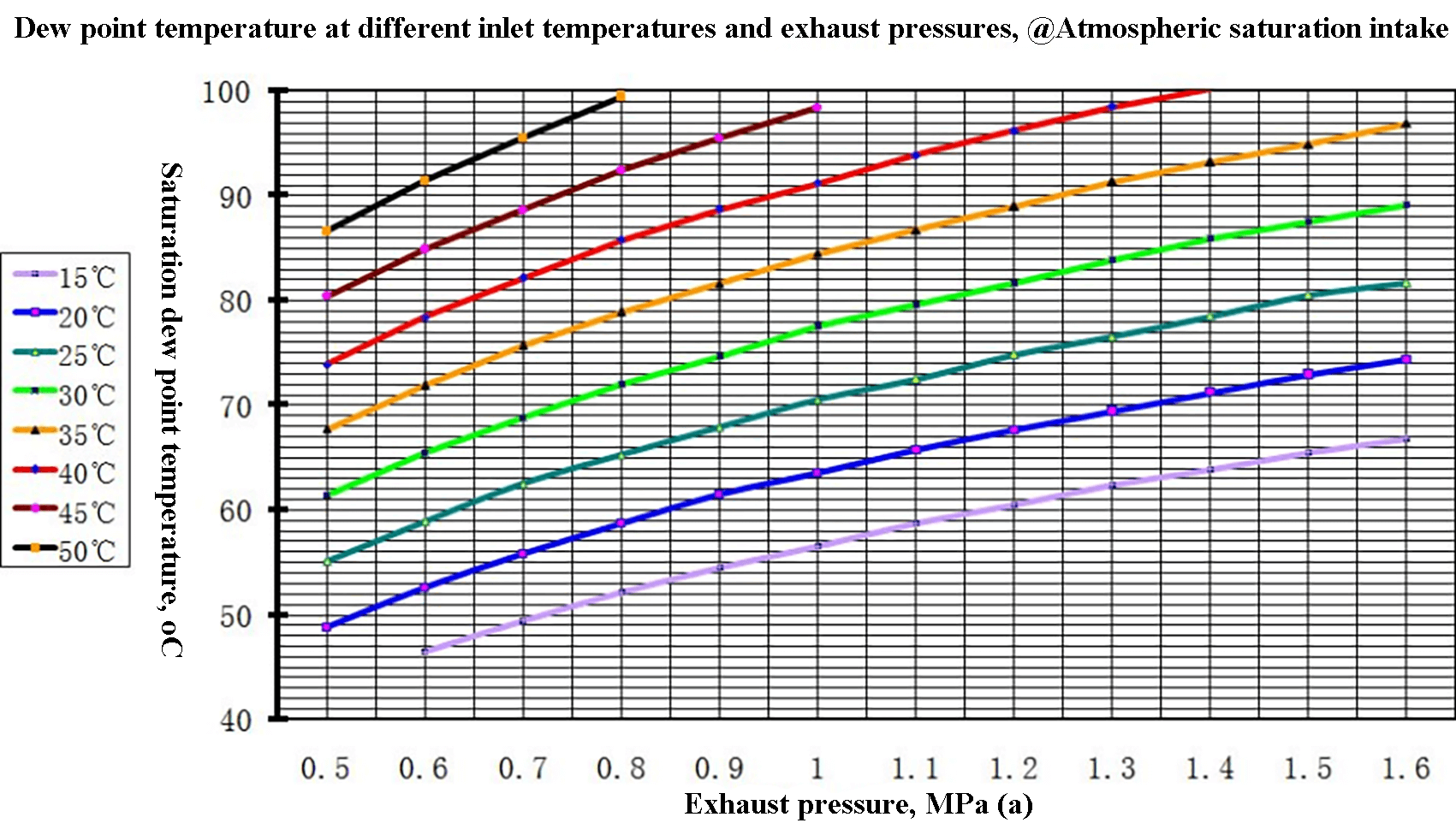
Fig. 14 Saturated air pressure dew point
7.5 pay attention to daily maintenance
1) Before starting work every day, it is necessary to drain the condensate from the air tank and check whether there are oil stains in the condensed water.
2) The condition of oil return from the oil-gas separator oil return pipe to the compressor main motor must be monitored through the sight glass (Figure 15) to determine whether the oil content in the exhaust gases is high or low and whether the lubricating oil or oil separation core needs to be replaced.
The. High speed airflow carrying a small amount of lubricating oil is visible through the sight glass – this is considered normal;
B. The sight glass is full of lubricating oil and moves slowly – this indicates a blockage in the piping and needs to be cleaned;
w. The high-speed air flow carrying a significant amount of lubricating oil is visible through the sight glass – this suggests that the oil separation effect is weak, resulting in a high oil content in the exhaust gases and requires immediate attention.
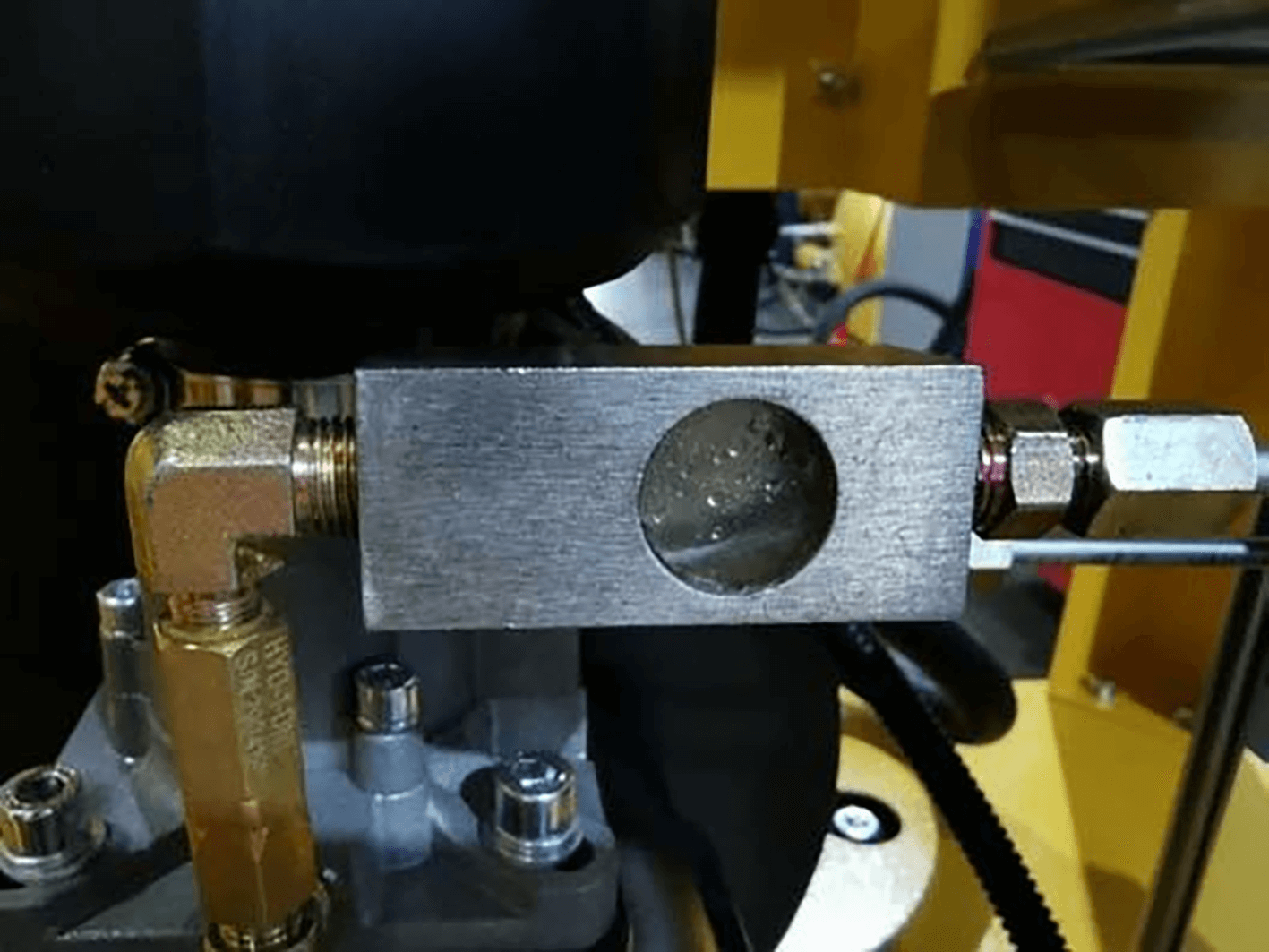
Fig. 15 Oil return sight glass
3) Replace the precision filter filter element within the period specified by the manufacturer.
4) Replace the air filter element, oil separator, oil filter and lubricating oil within the time specified by the manufacturer.
Conclusion: Compressed air is widely used as a supporting gas in laser cutting machines. It can be used in place of oxygen to cut carbon steel sheets and nitrogen to cut stainless steel, galvanized sheets, aluminum alloys and copper alloys. Proper selection and use of an air compressor not only guarantees the quality of laser cutting, but also provides good cutting efficiency and significant cost savings.
What are the specific advantages and disadvantages of using a screw-type air compressor on a laser cutting machine?
Using a screw-type air compressor as an auxiliary device for a laser cutting machine has the following specific advantages and disadvantages:
Benefits:
- Stable Air Pressure Output: The screw-type air compressor can supply stable high-pressure gas, which is crucial for blowing and cooling the cutting area during the laser cutting process, helping to achieve the best cutting effect.
- Efficient Operation: The dedicated screw-type air compressor can directly produce high-quality compressed air, ensuring the efficient operation of the laser cutting machine.
- Energy Saving and Consumption Reduction: Using a variable frequency controlled cooling fan can reduce noise and save energy.
Disadvantages:
- Output pressure limitation: Although the screw type air compressor is robust, durable and easy to maintain, its output pressure may be somewhat limited, which can potentially affect the quality and efficiency of laser cutting.
- Cost issues: In the long term, despite a relatively high initial investment, taking into account its stability and energy-saving characteristics, the long-term operating cost may decrease. However, for some small businesses or companies with limited initial budgets, the initially higher investment cost may be a factor to consider.
What is the working principle of post-processing devices (such as pipe filters, refrigerated dryers) of the air compressor used by the laser cutting machine and its effects on the quality of laser cutting?
The air compressor post-processing devices used by the laser cutting machine mainly include pipeline filters and refrigerated dryers. The operating principles of these devices and their effects on the quality of laser cutting are as follows:
Pipeline filter:
Its main function is to remove dust, impurities and other pollutants from compressed air. In the laser cutting process, compressed air serves as a crucial source of shielding gas, power source and dust blowing. If the compressed air contains a large amount of oil film or dust, it will directly affect the quality and efficiency of laser cutting. Therefore, installing water and oil mist filters is essential to ensure that the air entering the refrigerated dryer is clean, with a typical accuracy range of 3~25μm.
Refrigerated dryer:
The refrigerated dryer uses technology that dates back over 100 years, removing moisture by lowering the temperature of the compressed air, thus improving the dryness of the compressed air. This technology can effectively reduce the moisture content in compressed air, but its effect may vary depending on geographic location, requiring the selection of an appropriate dryer type (such as adsorption dryer or refrigerated dryer) based on actual conditions. Choosing a refrigerated dryer is crucial to the quality of your laser cutting, as moisture in the compressed air can cause the laser to diffuse, thus affecting cutting capacity and efficiency.

